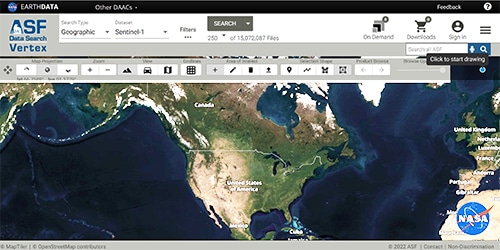NASA’s Applied Remote Sensing Training Program (ARSET) has opened a new open, online webinar series: An Introduction to Synthetic Aperture Radar (SAR) and Its Applications. This three-part introductory training, delivered in English and Spanish, will provide an introduction to SAR, including interferometric SAR (InSAR), as well as a review of the characteristics of historical, current, and upcoming openly available SAR satellite data. It will also explore the type of applications that each sensor can best address.
If you would like to join us or pass along to colleagues who will find it useful, please do so. Please see the training details and registration information below.
An Introduction to Synthetic Aperture Radar (SAR) and Its Applications
Synthetic Aperture Radar (SAR) has the capability to observe the Earth’s surface both day and night and through most weather conditions, making it an ideal sensor to support a wide range of science and applications. Additionally, unique capabilities of SAR include its ability to penetrate through various mediums (such as vegetation, snow, and soil), measure surface deformation and small movements on the order of centimeters, and its sensitivity to structure and to moisture content. These capabilities are valuable for monitoring vegetation structure and land use, detecting surface deformation and movements in land (e.g., earthquakes, landslides) and ice (e.g., glacier movement), flooding, and soil moisture, to name a few.
Historical and operational SAR data have been used to support numerous science and applications questions and needs. However, upcoming SAR satellite sensors, such as NISAR and BIOMASS, will enhance these capabilities with their unique observing frequencies and spatial and temporal resolutions.
This online webinar will provide an introduction to SAR, including interferometric SAR (InSAR), as well as a review of the characteristics of historical, current and upcoming openly available SAR satellite data. It will also explore the type of applications that each sensor can best address. Additionally, this webinar will discuss online sources of openly available SAR data, along with tools, software, and other resources to understand, explore, and facilitate the analysis of SAR data.
Learning Objectives:
- Recognize basic features and functionality of Synthetic Aperture Radar (SAR)
- Evaluate SAR sensor characteristics for addressing different science questions and application areas
- Interpret the information content in SAR images to distinguish different features (e.g., vegetation, water, inundation) detected by the sensor
- Evaluate creation of an interferogram through interferometric SAR (InSAR)
- Interpret an interferogram to measure surface deformation and small movements
- Compare and contrast the capabilities of historic, current, and upcoming SAR data
- Access and visualize SAR data for a given location and time
Course Dates: November 6, 13, & 20, 2024
Time: 11:30-13:30 EST (UTC-5)
To Register:
English: https://go.nasa.gov/47BRLS1
Spanish: https://go.nasa.gov/4ddMlxS
Audience: This training is primarily intended for Remote sensing end users, geospatial analysts, academics and students, managers from local, state, federal government, and NGO’s.
Course Format: Three 2-hour parts including Q&A.
Retweet option: https://x.com/nasaarset/status/1838231245936795756?s=46
Introducción al Radar de Apertura Sintética (SAR) y sus Aplicaciones
El Radar de Apertura Sintética (SAR, por sus siglas en inglés) puede observar la superficie de la Tierra tanto de día como de noche y bajo casi cualquier tipo de condición meteorológica, lo que lo hace un sensor ideal para apoyar una amplia gama de aplicaciones científicas. Además, SAR puede penetrar a través de varios medios (como la vegetación, nieve, suelo), medir la deformación y pequeños movimientos en la superficie terrestre (del orden de centímetros), y la señal es sensible a la estructura y a la humedad en la superficie. Estas características son valiosas para monitorear la estructura de la vegetación y el uso del suelo, detectar deformaciones y movimientos en la superficie terrestre (p.ej., terremotos y deslizamientos de tierra) y en el hielo (p.ej., movimiento de glaciares), inundaciones y humedad del suelo, entre otros.
Los datos históricos y operativos de SAR han apoyado numerosas investigaciones científicas y aplicaciones. Sin embargo, los próximos sensores satelitales SAR, como NISAR y BIOMASS, mejorarán aún más estas capacidades con sus frecuencias de observación, así como sus resoluciones espaciales y temporales.
Este webinar en línea presentará una introducción a SAR, incluyendo SAR interferométrico (InSAR), así como un repaso de las características de los datos de SAR históricos, actuales y futuros. También explorará el tipo de aplicaciones que cada sensor puede abordar más efectivamente. Además, este webinar repasará las fuentes en línea de datos SAR de acceso abierto, junto con herramientas, software y otros recursos para ayudar a entender, explorar y analizar datos SAR.
Objectivos de Aprendizaje: Al final de esta capacitación, los participantes podrán:
- Reconocer las características y funcionalidades básicas del Radar de Apertura Sintética (SAR)
- Evaluar las características de los sensores SAR para abordar diferentes investigaciones científicas y aplicaciones
- Interpretar el contenido informático en imágenes SAR para distinguir características en la superficie (p.ej., vegetación, agua, inundación) detectadas por el sensor
- Evaluar la creación de un interferograma por medio de SAR interferométrico (InSAR)
- Interpretar un interferograma para medir pequeñas deformaciones y movimientos en la superficie
- Comparar y contrastar las capacidades de datos SAR históricos, actuales y futuros
- Acceder y visualizar datos SAR sobre un lugar determinado
Audiencia Meta: Usuarios de teledetección, analistas geoespaciales, académicos y estudiantes, gerentes de gobiernos locales, estatales y federales y ONGs.
Fechas: El 6, 13 y 20 de noviembre de 2024
Inscripciones:
- español: 14h30 a 16h30 Hora Este de EE.UU (UTC-5): https://go.nasa.gov/4ddMlxS
- inglés: 11h30 a 13h30 Horario Este de EE.UU (UTC-5): https://go.nasa.gov/47BRLS1
Formato del Curso: Tres sesiones de 2 horas cada una
Retweet option (Spanish): https://x.com/NASAARSET/status/1838231245936795756




